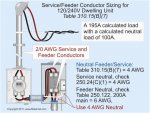- Location
- Windsor, CO NEC: 2017
- Occupation
- Service Manager
I was cruising along, minding my own business, and got broadsided by this graphic:

I don't see how this can be accurate. If I have a calculated neutral load of 100A, it is still protected by a 200A OCPD at the service, so the feeder rating is still 200A, is it not? How can the neutral use the 310.15(B)(7) 100A rating column for sizing?
Looking at 310.15(B)(7)
220.61 would have figured into finding my 100A in the first place.
230.42 would apply to the service neutral, and would require a #3 THHN.
As I see it, my steps in solving this problem for the service conductors are
1. Determine the minimum conductor size for 100A per 310.15(B)(16). (#3 CU THHN)
2. Verify that the neutral is big enough for short circuit current (250.24(C)(1) ---> 250.66 (#4, which is smaller than the #3 required by 230.42)).
So I'm left with a #3, not a #4, right? :huh:

I don't see how this can be accurate. If I have a calculated neutral load of 100A, it is still protected by a 200A OCPD at the service, so the feeder rating is still 200A, is it not? How can the neutral use the 310.15(B)(7) 100A rating column for sizing?
Looking at 310.15(B)(7)
215.2 would apply to the feeder neutral, and would require a #3 CU THHN.The grounded conductor shall be permitted to be smaller than the ungrounded conductors, provided the requirements of 215.2, 220.61, and 230.42 are met.
220.61 would have figured into finding my 100A in the first place.
230.42 would apply to the service neutral, and would require a #3 THHN.
As I see it, my steps in solving this problem for the service conductors are
1. Determine the minimum conductor size for 100A per 310.15(B)(16). (#3 CU THHN)
2. Verify that the neutral is big enough for short circuit current (250.24(C)(1) ---> 250.66 (#4, which is smaller than the #3 required by 230.42)).
So I'm left with a #3, not a #4, right? :huh:


